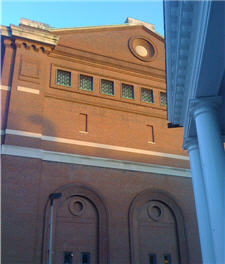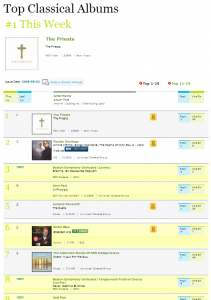It’s that time of year again. My colleagues and I in the Tanglewood Festival Chorus have put away our Holiday Pops scores in preparation for tackling more sublime repertoire. This upcoming concert, the US premier of James Macmillan‘s St. John Passion, a joint commission by the BSO and the London Symphony in honor of Sir Colin Davis’s 80th birthday and under his baton, should fit that adjective nicely.
The Boosey and Hawkes catalog entry for the Passion dryly notes the choral “level of difficulty” as “5 (the greatest).” Other singers have noted some of the challenges without going into details. At the risk of going in over my head, I’ll take a shot at describing both the difficulties and their payoffs.
Voices: The Passion is not shy in its use of choral forces, leveraging a small “narrator chorus” to perform the role sometimes filled by an Evangelist solo in the Bach settings of the Passions, in addition to a large chorus performing the traditional functions (Pharisees, crowd reactions, and chorales) and some more dramatic semi-soloistic roles (Pilate and Peter), with only one role for a true soloist, Christ himself. That’s a lot of moving parts and a lot of work for the chorus, which is not unusual for any Passion. What is a little more unusual is the…
Vocal writing: The text of the Passion is Latin and English, with traditional liturgical poems added to the Biblical text. The narrator chorus is written with plainchant in mind, but is generally written in four-part harmonies that are miles away from traditional Gregorian forms and rhythms. The chorus’s parts are even more gnarly, with vocal effects ranging from Sprechstimme and eight-to-twelve-voice chromatic passages to simultaneous juxtapositions of the Stabat Mater text with an English-language lullaby inspired by the Coventry Carol. The vocal ornamentation and rhythms are unusual as well, with Christ’s muezzin-like melismas reminding us that the original Biblical setting would have been more at home with the vocal traditions of the Middle East than that of Bach. For a chorus like the TFC, used to memorizing everything from the old warhorses like the Beethoven 9 to modern works like the Bolcom 8th Symphony, the combination of all of the above suggested that having scores in the performance might be a really good idea. That said, there are substantial portions of the work that are now firmly lodged somewhere in my cerebellum and won’t go away. And that’s due to…
The overall effect: MacMillan has a lot of forces and tools at his command, and he uses them to move the narrative of the story through to its inexorable conclusion with a lot of jaw-dropping effects along the way. Peter’s triple denial of Christ, sung by four-part men’s chorus, trips over itself singing, “I am not… I am… not,” dropping an octave down from vehemence into a piano unison in a strong psychological portrayal of the shame of the lie. The chorale on Judas’s betrayal of Christ (“Judas mercator pessimus”) begins gangbusters with a condemnatory declamation before improbably melting away to a jewel-like setting of his request of a kiss from Christ for the second sopranos and second tenors, then sets the “Melius illi erat” (“It would have been better if he had never been born”) as a Renaissance motet accompanied by fast recitation of text (an effect not unlike the library scene in Wings of Desire). The Crucifixio employs the classic cross vocal motif as a starting point (a four note melody moving down and up around a central tone), suspending Bach chorale harmonies on long whole-note phrases that decrescendo into a stunned silence.
But it’s the Stabat Mater in part 7 that really brings home the genius of all the moving parts of the work, with narrator chorus describing the fate of Mary, the inner voices sing the Latin poem in a breathtaking melismatic canon of fourths and fifths… and the outer voices (soprano and bass) sing a gentle lullaby to the deceased Christ, all at the same time–before closing on a quote from Bach made utterly personal: “Your sacred head is wounded.” It’s one of those moments outside of time that don’t come along too often in symphonic repertoire. I’m looking forward to continuing to journey into the work. Hopefully some of you can be there for the performance with me.






 Words cannot express the emotions I felt, after a weekend in the 50s, I awoke this morning to see big fat flakes of snow coming down. I keep thinking that I’m used to it, but at heart I’m still a Virginia boy; snow is a rare treat at the beginning of winter and a stupefying chore at the end. I can tell my town is reeling a little bit too; our street wasn’t plowed, a fact I didn’t fully appreciate until I began the descent down the steep hill leading down to Mass Ave. The hill was completely covered in snow turning rapidly to ice, and I had to really jam on the brakes at the top of the hill to keep it a controlled descent.
Words cannot express the emotions I felt, after a weekend in the 50s, I awoke this morning to see big fat flakes of snow coming down. I keep thinking that I’m used to it, but at heart I’m still a Virginia boy; snow is a rare treat at the beginning of winter and a stupefying chore at the end. I can tell my town is reeling a little bit too; our street wasn’t plowed, a fact I didn’t fully appreciate until I began the descent down the steep hill leading down to Mass Ave. The hill was completely covered in snow turning rapidly to ice, and I had to really jam on the brakes at the top of the hill to keep it a controlled descent.